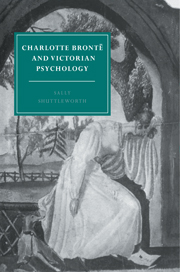Book contents
- Frontmatter
- Contents
- Acknowledgements
- Introduction
- PART ONE PSYCHOLOGICAL DISCOURSE IN THE VICTORIAN ERA
- 1 The art of surveillance
- 2 The Haworth context
- 3 Insanity and selfhood
- 4 Reading the mind: physiognomy and phrenology
- 5 The female bodily economy
- PART TWO CHARLOTTE BRONTË'S FICTION
- Conclusion
- Notes
- Index
- CAMBRIDGE STUDIES IN NINETEENTH-CENTURY LITERATURE AND CULTURE
3 - Insanity and selfhood
Published online by Cambridge University Press: 06 November 2009
- Frontmatter
- Contents
- Acknowledgements
- Introduction
- PART ONE PSYCHOLOGICAL DISCOURSE IN THE VICTORIAN ERA
- 1 The art of surveillance
- 2 The Haworth context
- 3 Insanity and selfhood
- 4 Reading the mind: physiognomy and phrenology
- 5 The female bodily economy
- PART TWO CHARLOTTE BRONTË'S FICTION
- Conclusion
- Notes
- Index
- CAMBRIDGE STUDIES IN NINETEENTH-CENTURY LITERATURE AND CULTURE
Summary
In the year of the publication of Villette, a writer in The Times offered the following observations on insanity: ‘Nothing can be more slightly defined than the line of demarcation between sanity and insanity … Make the definition too narrow, it becomes meaningless; make it too wide, the whole human race are involved in the drag-net.’ The sentiments expressed are indicative of mid-Victorian fears concerning the delimitation of insanity: no longer were the insane regarded as an outcast group, a sub-human species to be locked away with paupers and criminals. During the first half of the nineteenth century a radical transformation had occurred in attitudes towards insanity which culminated in the passing of the two Lunatic Acts in 1845, and the setting up of public asylums. For the first time the insane were to be radically distinguished from the criminal or indigent. These developments were accompanied by the rise of theories for the treatment of the insane which stressed the possibility of recuperation. Under the regime of ‘moral management’ the mentally disturbed could be healed and returned to society. Whilst earlier theorists had tended to emphasize the animal nature of the insane, the moral managers now stressed their membership of a common humanity. Thus at the same time that insanity was being constructed as a distinct social category, the borders separating it from sanity were also being eroded.
Medical writings of the period constantly drew attention to the lurking threat of insanity which menaced all individuals.
- Type
- Chapter
- Information
- Charlotte Brontë and Victorian Psychology , pp. 34 - 56Publisher: Cambridge University PressPrint publication year: 1996

